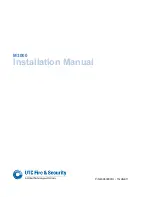
270
IBM System Storage N series Hardware Guide
OS kernel
After a kernel is selected, the second stage boot loader locates the kernel binary and loads
into memory the initial RAM disk image. The kernel then checks and configures hardware and
peripherals, and extracts the initial RAM disk image into load drivers and modules that are
needed to boot the system. It also mounts the root device.
Continue system start
After the kernel and its modules are loaded, a high-level system initialization is run by the
/sbin/init
program. This program is the parent process of all other subsequent start
processes. The
/sbin/init
program runs
/etc/rc.d/rc.sysinit
and its corresponding
scripts. This process is followed by running
/etc/inittab
,
/etc/rc.d/init.d/functions
, and
the appropriate
rc
directory as configured in
/etc/inittab
. For example, if the default
runlevel in
/etc/inittab
is configured as runlevel 5,
/sbin/init
runs scripts under the
/etc/rc.d/rc5.d/
directory.
Installing
Red Hat Enterprise Linux 5.2
The installation process that is described here assumes that the server does not have any
special hardware (SCSI card or HBA) that requires a specific Linux driver. If you have a
device driver that you must load during the installation process, enter
Linux dd
at the
installation boot prompt before the installation wizard is loaded.
The installation process is similar to local disk installation. To set up a Linux SAN boot,
complete the following steps:
1. Insert the Linux installation CD and reboot the host. During the installation, you can see
the LUN and install the OS on it.
2. Click Next and follow the installation wizard as you normally do with a local disk
installation.
LUNs that are connected that use a block protocol (for example, iSCSI or FCP) to Linux hosts
might require special partition alignment for best performance. For more information, see this
website:
http://www.ibm.com/support/docview.wss?uid=ssg1S1002716&rs=573
Tip: RHEL5 can now detect, create, and install to dm-multipath devices during installation.
To enable this feature, add the parameter
mpath
to the kernel boot line. At the initial Linux
installation panel, enter
linux mpath
and press Enter to start the Red Hat installation.
Attention: After you successfully install Red Hat Enterprise Linux 5.2, add the remaining
WWPN for all other HBAs to the igroup and install the FCP Linux Host Utilities.
Содержание N Series
Страница 2: ......
Страница 12: ...x IBM System Storage N series Hardware Guide ...
Страница 18: ...xvi IBM System Storage N series Hardware Guide ...
Страница 20: ...xviii IBM System Storage N series Hardware Guide ...
Страница 22: ...2 IBM System Storage N series Hardware Guide ...
Страница 32: ...12 IBM System Storage N series Hardware Guide ...
Страница 52: ...32 IBM System Storage N series Hardware Guide ...
Страница 64: ...44 IBM System Storage N series Hardware Guide ...
Страница 90: ...70 IBM System Storage N series Hardware Guide ...
Страница 122: ...102 IBM System Storage N series Hardware Guide ...
Страница 194: ...174 IBM System Storage N series Hardware Guide ...
Страница 200: ...180 IBM System Storage N series Hardware Guide ...
Страница 224: ...204 IBM System Storage N series Hardware Guide ...
Страница 244: ...224 IBM System Storage N series Hardware Guide ...
Страница 292: ...272 IBM System Storage N series Hardware Guide ...
Страница 298: ...278 IBM System Storage N series Hardware Guide ...
Страница 300: ...280 IBM System Storage N series Hardware Guide ...
Страница 314: ...294 IBM System Storage N series Hardware Guide ...
Страница 326: ...306 IBM System Storage N series Hardware Guide ...
Страница 327: ... Copyright IBM Corp 2012 2014 All rights reserved 307 Part 5 Appendixes Part 5 ...
Страница 328: ...308 IBM System Storage N series Hardware Guide ...
Страница 362: ...342 IBM System Storage N series Hardware Guide ...
Страница 366: ...IBM System Storage N series Hardware Guide IBM System Storage N series Hardware Guide ...
Страница 367: ......
















































